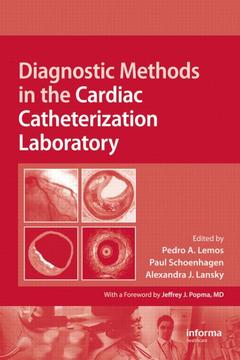Diagnostic Methods in the Cardiac Catheterization Laboratory

The tools necessary for correctly identifying complex coronary lesions and plaques. The data required to accurately diagnose rare disease progression and patterns. With Diagnostic Methods in the Cardiac Catheterization Laboratory, all of the essential diagnostic modalities you need in the lab are at your fingertips.
This new force in cardiology is the premier reference guide to advanced clinical approaches and the specialized conditions that every interventional cardiologist encounters. It depicts the unusual and unique situations in the catheterization lab and supplies the knowledge required of clinicians that goes beyond the fundamental methods and techniques.
Key topics discussed include:
- promising new technology, including machines and contrast agents
- intracardiac pressure and flow measurement, and shunt detection
- qualitative and quantitative angiography
- intravascular ultrasound, derived methods, and intracardiac ultrasonography
- optical coherence and multidetector-computed tomography
- electromechanical mapping (NOGA system)
- baseline evaluation and therapeutic monitoring
- clinical applications of quantitative coronary angiography
- pre-procedure planning and intra-procedure of CTO treatment
Coronary Anomalies and Fistulae: An Overview of Important Entities. Practical Uses of Online Quantitative Coronary Angiography. Preintervention Evaluation of Chronic Total Occlusions. Evaluation of Myocardial Perfusion. Challenges in the Assessment of Bifurcation Lesions. The Vulnerable Plaque and Angiography. Merits and Limitations of IVUS for the Evaluation of Ambiguous Lesions. An In-Depth Insight of Intravascular Ultrasound for Coronary Stenting. Intravascular Ultrasound Guidance of Stent Deployment. A Practical Approach to IVUS for In-Stent Restenosis and Thrombosis. Pharmacological Intervention Trials. IVUS and IVUS-Derived Methods for Vulnerable Plaque Assessment. Evaluation of Acute and Chronic Microvascular Coronary Disease. Collateral Function Assessment. Merits and Limitations of FFR for the Evaluation of Ambiguous Lesions: Special Attention to Ostial Location, Bifurcation, Tandem Lesion, Ectasic Vessel, In-Stent Restenosis, and Diffuse Disease. Clinical Applications of OCT. Viability Assessment and Cardiac Function. Cardiovascular Interventional MR Imaging. Role of MDCT for the Diagnosis of Coronary Anomalies and Fistulae. Coronary Stenosis Evaluation with CT Angiography. Multidetector Computed Tomography Imaging for Myocardial Perfusion, Viability, and Cardiac Function. Evaluation of LV Function in Cases of Global and Segmental Disease. Current Noninvasive and Invasive Diagnostic Approach to Hypertrophic Cardiomyopathy. The Role of the Cath Lab in Patients with Advanced Heart Failure and Cardiac Transplantation. Evaluation of Common Congenital Heart Defects in the Adult. Tips and Tricks of the Angiographic Anatomy of the Carotid Arteries and Vertebrobasilar System. Invasive Evaluation of Renal Artery Stenosis. Angiographic Assessment of Lower Extremity Arterial Insufficiency.
Date de parution : 12-2009
17.8x25.4 cm
Date de parution : 06-2017
17.8x25.4 cm
Thème de Diagnostic Methods in the Cardiac Catheterization Laboratory :
Mots-clés :
C24 Count; Coronary Artery; Coronary Anomalies and Fistulae: An Overview of Important Entities; DES; The Vulnerable Plaque and Angiography; IVUS; Pharmacological Intervention Trials; Left Anterior Descending Coronary Artery; Evaluation of Common Congenital Heart Defects in the Adult; Pulmonary Artery; Angiographic Assessment of Lower Extremity Arterial Insufficiency; LAO; Hypertrophic Cardiomyopathy; MDCT; Stent Thrombosis; Pe Rc; Progressive Disease; Left Main Coronary Artery; CTO; In-stent Restenosis; Left Main; Bifurcation Lesions; IVUS Image; Myocardial Viability; Coronary Anomalies; CAAs; Myocardial Perfusion; Bland White Garland Syndrome; Contrast Induced Nephropathies; Side Branch



